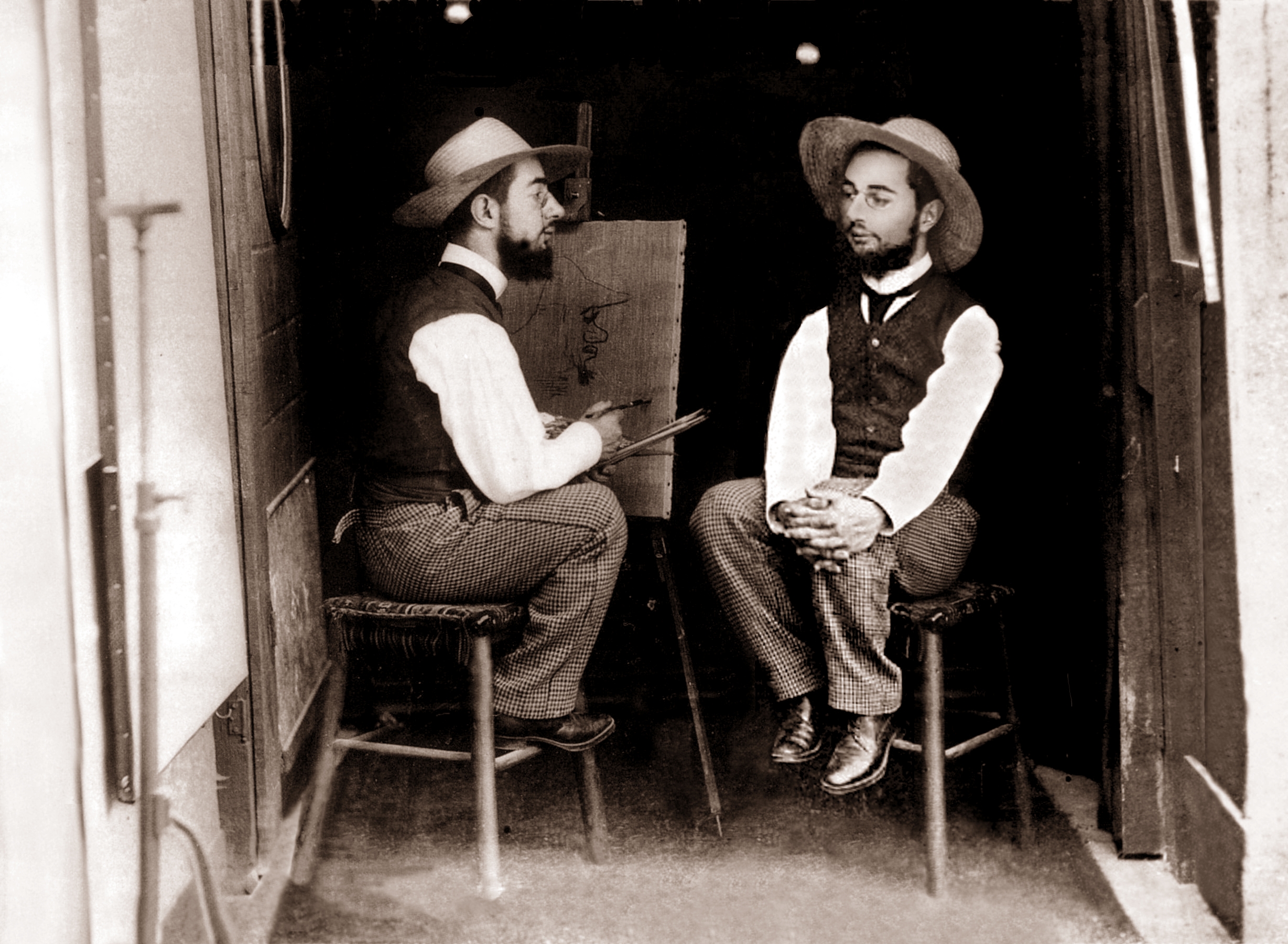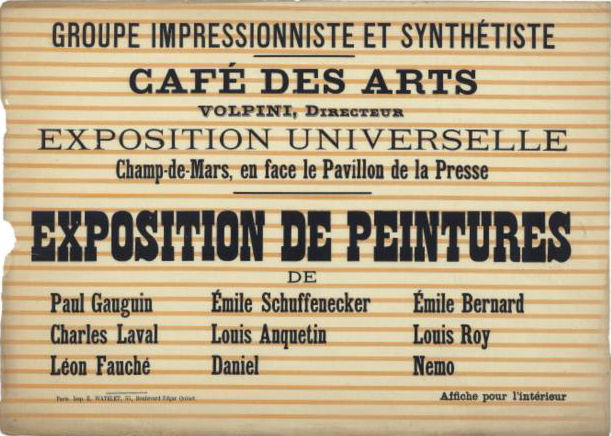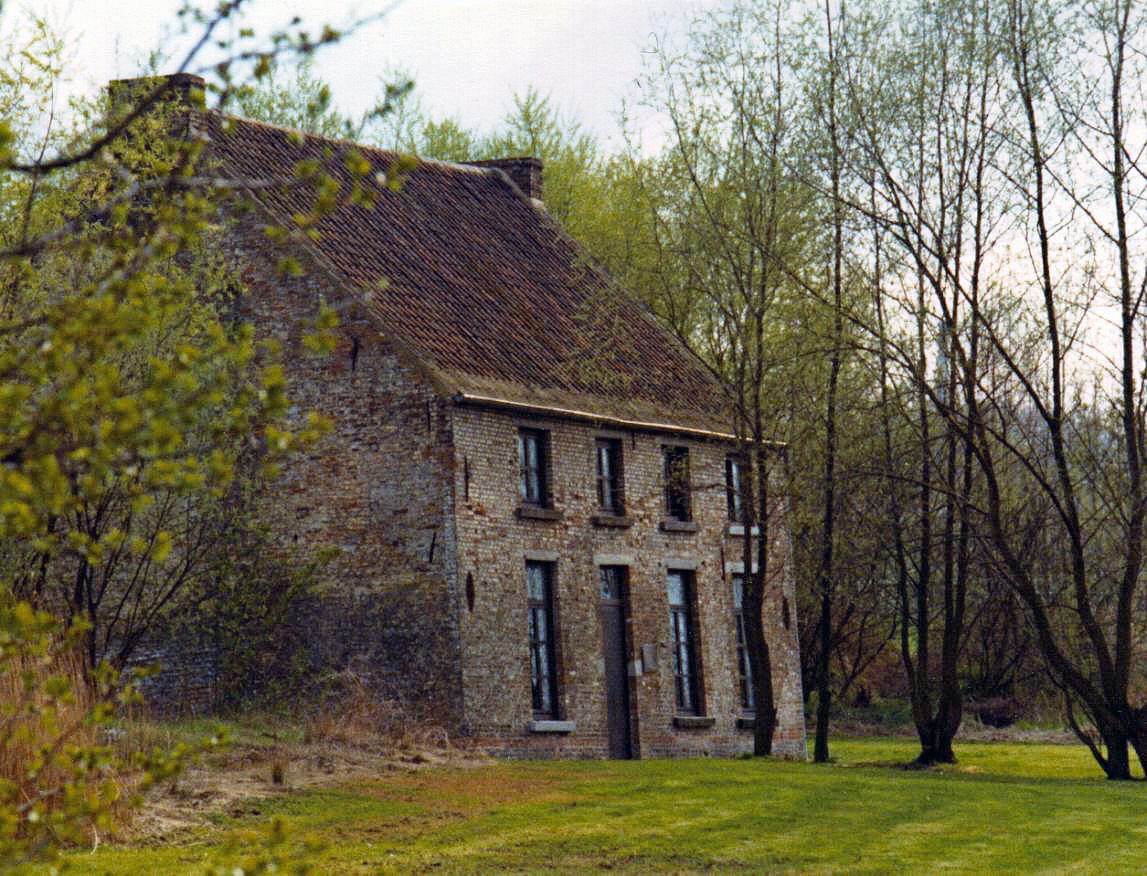|
Toulouse-Lautrec
''Comte'' Henri Marie Raymond de Toulouse-Lautrec-Monfa (24 November 1864 – 9 September 1901), known as Toulouse-Lautrec (), was a French painter, printmaker, draughtsman, caricaturist, and illustrator whose immersion in the colourful and theatrical life of Paris in the late 19th century allowed him to produce a collection of enticing, elegant, and provocative images of the sometimes decadent affairs of those times. Born into the aristocracy, Toulouse-Lautrec broke both his legs during adolescence, leaving him with a stunted appearance. In later life, he developed an affinity for brothels and prostitutes that directed the subject matter for many of his works, which record details of the late-19th-century bohemian lifestyle in Paris. He is among the painters described as being Post-Impressionists, with Paul Cézanne, Vincent van Gogh, Paul Gauguin, and Georges Seurat also commonly considered as belonging in this loose group. In a 2005 auction at Christie's auction hous ... [...More Info...] [...Related Items...] OR: [Wikipedia] [Google] [Baidu] |
Albi
Albi (; ) is a commune in France, commune in southern France. It is the prefecture of the Tarn (department), Tarn Departments of France, department, on the river Tarn (river), Tarn, 85 km northeast of Toulouse. Its inhabitants are called ''Albigensians'' (, ). It is the seat of the Roman Catholic Archdiocese of Albi, Archbishop of Albi. The episcopal city, around the Albi Cathedral, Cathedral Sainte-Cécile, was added to the UNESCO list of World Heritage Sites in 2010 for its unique architecture. The site includes the Musée Toulouse-Lautrec, dedicated to Henri de Toulouse-Lautrec, the artist who was born in Albi. Administration Albi is the seat of four Canton in France, cantons, covering 16 Commune in France, communes, with a total population of 72,416 (2019). History The first human settlement in Albi was in the Bronze Age (3000–600 Before Christ, BC). After the Ancient Rome, Roman conquest of Gaul in 51 BC, the town became ''Civitas Albigensium'', the territor ... [...More Info...] [...Related Items...] OR: [Wikipedia] [Google] [Baidu] |
Le Lit (Toulouse-Lautrec)
''Le Lit'' ('The Bed') (also known as ''Dans le lit'', 'In Bed') is a painting by Henri de Toulouse-Lautrec from around 1892 which depicts two women sharing a bed. The painting has been held by public collections in France since 1937, and by the Musée d'Orsay in Paris since 1986. Inspiration Toulouse-Lautrec became fascinated by the nightlife in Paris, particularly sex workers. Through the 1890s, he spent more and more time painting everyday scenes of life in the official brothels, the '' maisons closes''. In 1892, he was commissioned to produce paintings for the salon at a brothel on the . He spent time observing the brothel, its residents and visitors, while they worked and at quieter moments, and made sixteen portraits of the sex workers. These paintings demonstrate a close and intimate observation and compassion towards the subjects, without any sense of sensationalism or voyeurism. Description ''Le Lit'' was made in oil paints on cardboard, mounted on wood, and meas ... [...More Info...] [...Related Items...] OR: [Wikipedia] [Google] [Baidu] |
La Toilette (Toulouse-Lautrec)
''La Toilette'', also known as ''Rousse'', is a painting by Henri de Toulouse-Lautrec, from 1889. The painting depicts a red-headed woman, stripped to the waist, seated on the floor, facing away from the viewer, just before or just after bathing. Held by public collections in France since 1914, it has been at the Musée d'Orsay, in Paris, since 1983. The painting depicts a domestic scene of a woman, sitting on a plain towel or sheet over a dark rug on the bare floorboards. She is largely undressed, with bare back, arms and head, hair tied back, and bare right thigh visible. A swathe of plain fabric is wrapped around her waist, with a black boot or stocking on her right lower leg. Other clothing is draped over a chair to the left. The work was painted in oils on cardboard, and measures . It employs a light colour palette, predominantly blues with yellowish greens and red for the woman's hair, thinned with turpentine to create a loose effect. The Impressionist image, similar to a ... [...More Info...] [...Related Items...] OR: [Wikipedia] [Google] [Baidu] |
At The Moulin Rouge
''At the Moulin Rouge'' () is an oil-on-canvas painting by French artist Henri de Toulouse-Lautrec. It was painted between 1892 and 1895. Included in the background is a self-portrait of the artist in profile. It is one of a number of works by Toulouse-Lautrec depicting the Moulin Rouge cabaret built in Paris in 1889. The painting portrays near its center a group of three men and two women sitting around a table situated on the floor of the cabaret. From left to right, the people at the table include: writer Édouard Dujardin, dancer La Macarona, photographer Paul Secau, photographer Maurice Guibert, and, facing away, Jane Avril, being the focal point of the group - recognizable by her flaming red-orange hair. In the right foreground, apparently sitting at a different table, is a partial facial view of English dancer May Milton, with painted red lips, her face aglow in a distinctive greenish light and shadow. In the background standing on the right fixing her hair is Moulin R ... [...More Info...] [...Related Items...] OR: [Wikipedia] [Google] [Baidu] |
Art Nouveau
Art Nouveau ( ; ; ), Jugendstil and Sezessionstil in German, is an international style of art, architecture, and applied art, especially the decorative arts. It was often inspired by natural forms such as the sinuous curves of plants and flowers. Other characteristics of Art Nouveau were a sense of dynamism and movement, often given by asymmetry or whiplash lines, and the use of modern materials, particularly iron, glass, ceramics and later concrete, to create unusual forms and larger open spaces.Sembach, Klaus-Jürgen, ''L'Art Nouveau'' (2013), pp. 8–30 It was popular between 1890 and 1910 during the Belle Époque period, and was a reaction against the academicism, eclecticism and historicism of 19th century architecture and decorative art. One major objective of Art Nouveau was to break down the traditional distinction between fine arts (especially painting and sculpture) and applied arts. It was most widely used in interior design, graphic arts, furniture, glass ... [...More Info...] [...Related Items...] OR: [Wikipedia] [Google] [Baidu] |
La Blanchisseuse (Toulouse-Lautrec)
''La Blanchisseuse'' (, ''The Laundress'') is an 1886 oil-on-canvas painting by French artist Henri de Toulouse-Lautrec. In November 2005, it was sold for US$22.4million at auction by Christie's Christie's is a British auction house founded in 1766 by James Christie (auctioneer), James Christie. Its main premises are on King Street, St James's in London, and it has additional salerooms in New York, Paris, Hong Kong, Milan, Geneva, Shan .... The subject of laundresses, also known as washerwomen, was a popular one in art, especially in France. ''La Blanchisseuse'' was painted by Toulouse-Lautrec and posed for by Carmen Gaudin in 1886. This painting showcases the gritty life and working conditions endured by the working classes throughout the 19th century. The painting was in storage until 2005, when an anonymous buyer acquired it for 22.4 million dollars, breaking the record for the most expensive Lautrec painting sold at an auction. References {{DEFAULTSORT:Blanchisseus ... [...More Info...] [...Related Items...] OR: [Wikipedia] [Google] [Baidu] |
Count Alphonse De Toulouse-Lautrec Montfa
Count, Comte Alphonse de Toulouse-Lautrec Montfa (1838–1913) was a French aristocrat. A noted eccentric and fancier of horses, hawks, hunting, and kites, he was a "man out of time", whose vast wealth and royal connections allowed him to ignore convention. Once, the count appeared uninvited at a parade in Paris, riding in a Norwegian cart pulled by a Welsh pony, while flying a French Man-lifting kite, war-kite. When the parade officer protested, the enraged count challenged him to a duel. Both men fired their weapons and missed. Another time, he rode a mare in milk to the Cascade at the end of the Bois de Boulogne, milked the horse, and drank the milk for breakfast. He gave his pet hawks and cormorants holy water in the hope that they would go to heaven. He held little regard for his son Henri de Toulouse-Lautrec, Henri, who became a famous painter and poster artist, but could not ride a horse. Life Born in Albi on 10 August 1838, Alphonse de Toulouse-Lautrec Montfa was the son ... [...More Info...] [...Related Items...] OR: [Wikipedia] [Google] [Baidu] |
René Princeteau
René Pierre Charles Princeteau (18 July 1843 – 31 January 1914) was a French animal painter. Life René Princeteau was born in Libourne into a noble family. He was deaf and mute from birth. He studied at the Institut National de Jeunes Sourds de Paris. After attending sculpture classes with Dominique Fortuné Maggesi, he enrolled in 1865 at the École nationale supérieure des Beaux-Arts, where he studied under the direction of Auguste Dumont. He rented a studio at 233 rue du Faubourg Saint-Honoré. He was a friend of Alphonse de Toulouse-Lautrec, and tutored Henri de Toulouse-Lautrec in 1871. During the Franco-Prussian War The Franco-Prussian War or Franco-German War, often referred to in France as the War of 1870, was a conflict between the Second French Empire and the North German Confederation led by the Kingdom of Prussia. Lasting from 19 July 1870 to 28 Janua ..., he enlisted in the artillery of army of the Loire. He then accumulated in his notebooks a lot of n ... [...More Info...] [...Related Items...] OR: [Wikipedia] [Google] [Baidu] |
Post-Impressionism
Post-Impressionism (also spelled Postimpressionism) was a predominantly French art movement that developed roughly between 1886 and 1905, from the last Impressionist exhibition to the birth of Fauvism. Post-Impressionism emerged as a reaction against Impressionists' concern for the naturalistic depiction of light and colour. Its broad emphasis on abstract qualities or symbolic content means Post-Impressionism encompasses Les Nabis, Neo-Impressionism, Symbolism, Cloisonnism, the Pont-Aven School, and Synthetism, along with some later Impressionists' work. The movement's principal artists were Paul Cézanne (known as the father of Post-Impressionism), Paul Gauguin, Vincent van Gogh and Georges Seurat. The term Post-Impressionism was first used by art critic Roger Fry in 1906.Peter Morrin, Judith Zilczer, William C. Agee, ''The Advent of Modernism. Post-Impressionism and North American Art, 1900-1918'', High Museum of Art, 1986 Critic Frank Rutter in a review of the Salon ... [...More Info...] [...Related Items...] OR: [Wikipedia] [Google] [Baidu] |
Vincent Van Gogh
Vincent Willem van Gogh (; 30 March 185329 July 1890) was a Dutch Post-Impressionist painter who is among the most famous and influential figures in the history of Western art. In just over a decade, he created approximately 2,100 artworks, including around 860 oil paintings, most of them in the last two years of his life. His oeuvre includes Trees and Undergrowth (Van Gogh series), landscapes, Still life paintings by Vincent van Gogh (Paris), still lifes, Portraits by Vincent van Gogh, portraits, and Portraits of Vincent van Gogh, self-portraits, most of which are characterised by bold colours and dramatic Paintwork, brushwork that contributed to the rise of expressionism in modern art. Van Gogh's work was only beginning to gain critical attention before he died from a self-inflicted gunshot at age 37. During his lifetime, only one of Van Gogh's paintings, ''The Red Vineyard'', was sold. Born into an upper-middle-class family, Van Gogh drew as a child and was serious, qui ... [...More Info...] [...Related Items...] OR: [Wikipedia] [Google] [Baidu] |
Fernand Cormon
Fernand Cormon (; 24 December 1845 – 20 March 1924) was a French painter born in Paris. He became a pupil of Alexandre Cabanel, Eugène Fromentin, and Jean-François Portaels, and one of the leading historical painters of modern France. Biography His father was the playwright Eugène Cormon. His mother was Charlotte Furais, the actress. At an early age he attracted attention for the perceived sensationalism in his art, although for a time his powerful brush dwelled with particular delight on scenes of bloodshed, such as the ''Murder in the Seraglio'' (1868) and the ''Death of Ravana, King of Lanka'' at the Toulouse Museum. The Musée d'Orsay has his ''Cain fleeing before Jehovah's Curse''; and for the Mairie of the fourth arrondissement of Paris he executed in grisaille a series of panels: ''Birth, Death, Marriage, War'', etc. ''A Chiefs Funeral'', and a series of large paintings for the Museum of natural history in Paris with themes from the Stone Age, occupied him for sev ... [...More Info...] [...Related Items...] OR: [Wikipedia] [Google] [Baidu] |
Brothel
A brothel, strumpet house, bordello, bawdy house, ranch, house of ill repute, house of ill fame, or whorehouse is a place where people engage in Human sexual activity, sexual activity with prostitutes. For legal or cultural reasons, establishments often describe themselves as massage parlors, bars, strip clubs, body rub parlours, studios, or by some other description. Sex work in a brothel is considered safer than street prostitution. Legal status On 2 December 1949, the United Nations General Assembly approved the Convention for the Suppression of the Traffic in Persons and of the Exploitation of the Prostitution of Others. The convention came into effect on 25 July 1951 and by December 2013, had been ratified by 82 states. The convention seeks to combat prostitution, which it regards as "incompatible with the dignity and worth of the human person." Parties to the convention agreed to abolish regulation of individual prostitutes, and to ban brothels and Procuring (prostitu ... [...More Info...] [...Related Items...] OR: [Wikipedia] [Google] [Baidu] |






